


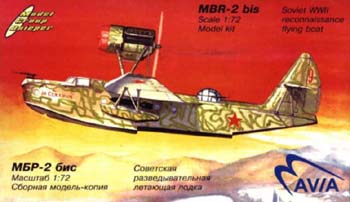 AVIA
1/72 MBR-2 bis Flying Boat
AVIA
1/72 MBR-2 bis Flying Boat
by James Gray
Introduction
In case your knowledge of the MBR-2bis is as good as mine (i.e. you don't know anything about it at all) it was designed by G.M. Beriev's Design Bureau, entering production in 1933. The bis version, powered by an M-103 engine delivering 860 to 960 HP, appeared in 1937. In June, 1941, over 560 MBR-2's were still in service, and while they were very slow and ill-armed, circumstances forced the Soviet Navy to use them, not just in flying night missions, but during the day, in reconnaissance, bombing, and anti-submarine work. They were still in service in 1945 in the Far East and were actually used against Japanese forces in Korea.
The Kit
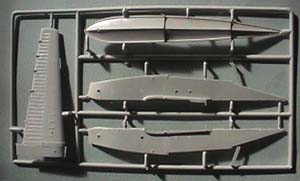 This
new kit is from Avia and Model Group Dnieper. The box certainly is dramatic,
with the subject aircraft flying against a lurid sunset. Inside this box
is crowded, wrapped loosely in a plastic bag, no less than eight separate
sprues. Seven sprues are cast in a soft, ugly gray-tan plastic. The remaining
sprue is clear. The clear sprue is superior to usual Eastern European
clear parts, being pretty clear and fairly thin, and as a little surprise
it includes itsy-bitsy green and red wingtip lenses. Of the remaining
sprues, the two with wingtip floats are duplicates. There is not much
flash, the details are mostly pretty clear, and mold
This
new kit is from Avia and Model Group Dnieper. The box certainly is dramatic,
with the subject aircraft flying against a lurid sunset. Inside this box
is crowded, wrapped loosely in a plastic bag, no less than eight separate
sprues. Seven sprues are cast in a soft, ugly gray-tan plastic. The remaining
sprue is clear. The clear sprue is superior to usual Eastern European
clear parts, being pretty clear and fairly thin, and as a little surprise
it includes itsy-bitsy green and red wingtip lenses. Of the remaining
sprues, the two with wingtip floats are duplicates. There is not much
flash, the details are mostly pretty clear, and mold 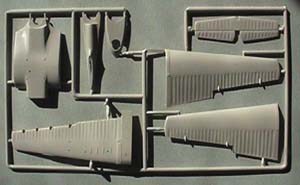 alignment
seems fine; however, there are a lot of sink marks. The worst are on the
hull. Inside the hull are grids of oversized stringer and rib detail in
the cockpits, and outside the hull are grids of sink marks. Also, very
much on the down side, the effect of cloth over the ribs in the wings
is very exaggerated and the ribs are not even straight. This looks like
a lot of trouble to correct. Oddly, the control surfaces look much better.
Finally, there are giant ejector-pin marks, but I think they are all on
interior surfaces.
alignment
seems fine; however, there are a lot of sink marks. The worst are on the
hull. Inside the hull are grids of oversized stringer and rib detail in
the cockpits, and outside the hull are grids of sink marks. Also, very
much on the down side, the effect of cloth over the ribs in the wings
is very exaggerated and the ribs are not even straight. This looks like
a lot of trouble to correct. Oddly, the control surfaces look much better.
Finally, there are giant ejector-pin marks, but I think they are all on
interior surfaces.
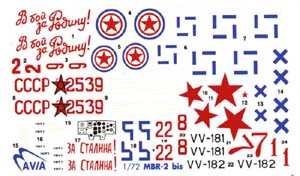 The
decal sheet looks pretty good. It includes decals for no less than 14
separate paint schemes! One is North Korean, four are Finnish, and the
remainder are Soviet Navy. The Finnish swastikas are broken up into crosses
and arms-on-white-circles, to make things harder but politically correct.
A decal for the instrument panel is included, but it's not very impressive.
The
decal sheet looks pretty good. It includes decals for no less than 14
separate paint schemes! One is North Korean, four are Finnish, and the
remainder are Soviet Navy. The Finnish swastikas are broken up into crosses
and arms-on-white-circles, to make things harder but politically correct.
A decal for the instrument panel is included, but it's not very impressive.
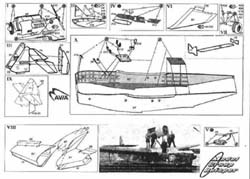 The
instruction sheets are really just exploded drawings, which don't offer
a lot of guidance. Also included are drawings of the sprues that show
the part numbers so small you can barely make them out, and several fuzzy
photographs of the actual aircraft and basic painting and decal guides
for those 14 different flying boats.
The
instruction sheets are really just exploded drawings, which don't offer
a lot of guidance. Also included are drawings of the sprues that show
the part numbers so small you can barely make them out, and several fuzzy
photographs of the actual aircraft and basic painting and decal guides
for those 14 different flying boats.
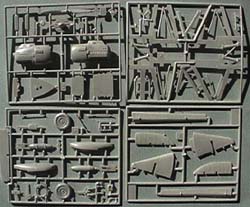 Additional
points of interest include the rather primitive casting of the machine
guns right into the scarff rings, and likewise the crude treatment of
the rubber boots on the beaching gear. On the other hand, the wheels on
the beaching gear, and the louvers on the engine housing are not bad at
all, likewise the
Additional
points of interest include the rather primitive casting of the machine
guns right into the scarff rings, and likewise the crude treatment of
the rubber boots on the beaching gear. On the other hand, the wheels on
the beaching gear, and the louvers on the engine housing are not bad at
all, likewise the 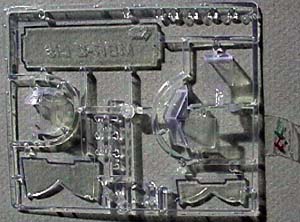 folding
anchor. Flaps and ailerons are separate items. A clear stand is included,
or you can install beaching gear.
folding
anchor. Flaps and ailerons are separate items. A clear stand is included,
or you can install beaching gear.
A dry fit of the major parts shows a fair fit, all in all, but the attachment of the outer wing assemblies to the hull/center wing section looks like it could use some support or even a home-made spar to add some strength.
Conclusion
Now, this review might put you off, and I admit I was put off myself when I opened the box up. However, in the light of more mature consideration, I think that this looks quite buildable. Sure, it will be quite a bit of work, but not too much more than, say, fixing up an old Matchbox or Airfix model. I give it a guarded recommendation to moderately experienced modellers, especially of course to any with an interest in Soviet aircraft.

Previous: Contents







